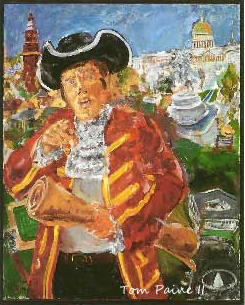[8] See the Treasury's
National Debt page : "Debt held by the public excludes the
portion of the debt that is held by government accounts... Debt held by the
public is the most meaningful of these concepts and measures the cumulative
amount outstanding that the government has borrowed to finance deficits." See also the GAO's
November 2011 audit of the public debt , pages 1-2, 7 n.2: "Debt held by the public" includes treasuries
held by Fed, and "represents a burden on today's economy"and may put upward
pressure on interest rates[.] [I] ntragovernmental
debt holdings typically do not. [They]
represent federal debt owed by Treasury to federal government
accounts--primarily federal trust funds such as Social Security and Medicare."
[9] Contrary to popular belief, the
constitutional record is perfectly clear re the inclusion of the sovereign's
fiat paper money power. Every Supreme
Court decision has upheld the power. The
first cases, e.g. Bronson v. Rodes,
74 U.S. 229 (1868), many tout as having held paper money unconstitutional. But they affirmed the power, except re bullion
contracts agreed before the legal tender act was passed. Even this limit was soon
overruled. See, e.g: Gregory v. Morris, 96 U.S. 619 (1877); Juilliard v. Greenman, 110 U.S. 421
(1884). The constitutional record is plain. On August 16, 1787, the Framers'
final money powers vote delisted "paper money" lest it "excite the opposition
of the" monopoly-bent "Monied interest," and be used to exploit the public's aggravated
paper-money phobia, so as to altogether exclude it. Before voting, Madison secured explicit agreement
that this did "not disable[e] the government from the use of public notes as
far as they could be safe and proper."
U.S. Const., Art. I, Sec 8. See
Madison's Notes
of the Debates , 470-471 . Throughout the ratification debates, the
sovereign's fiat paper-money power was well understood, albeit solely as a
prerogative of the far more responsible federal government. See The
Debate On The Constitution, part 2 at 94, 110, 148, 422-423, 476-477,
639-640, 659, 678. See also Paper
Money and the Original Understanding of the Coinage Clause , Robert
Natelson, Harvard Journal of Law & Public Policy, Vol. 31 No. 3 (2008).
[10] "Treasury
securities held by foreign and international investors represented an estimated
46% of debt held by the public." GAO
audit of the public debt, November 2011 ,
page 5. International and foreign shares
in the Fed, and so implicitly in the treasuries it owns, presumably put the
operationally offshore ownership well above 50%. Today,
these foreign-owned forces operate within, draining technology, jobs, and
money. How could "free" private capital not run to reliably higher profits from
third world sweat-shops and bank-blessed tax havens? Overseas financing and capital flight manifest
today's alien invasions. Tax
Haven U.S.A. Attracts Over $3 Trillion In Foreign Dirty Money
(Nicholas Shaxton, March, 2011) ironically evidences yet deeper corrosion.
(Note: You can view every article as one long page if you sign up as an Advocate Member, or higher).





